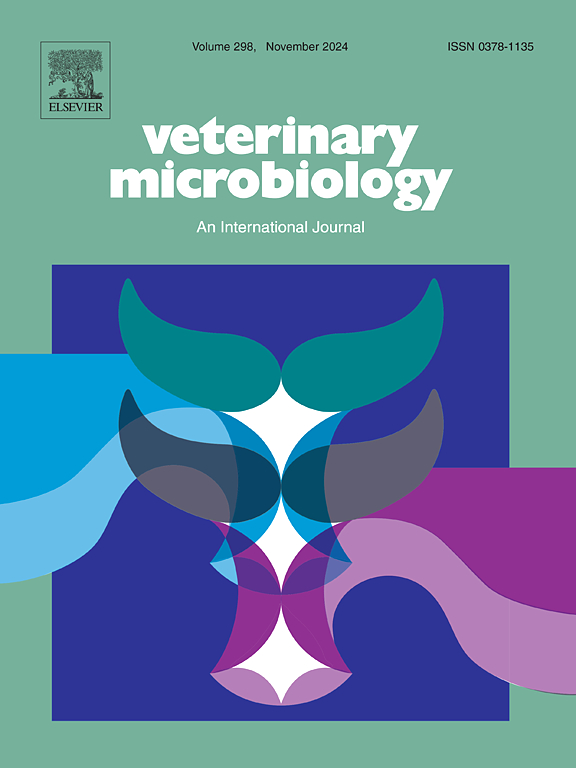Development of a colloidal gold nanoparticle-based lateral flow immunochromatographic (LFI) strip test for detecting Senecavirus A (SVA) antibodies in pigs using non-structural protein
IF 2.4
2区 农林科学
Q3 MICROBIOLOGY
引用次数: 0
Abstract
A rapid lateral flow immunochromatographic (LFI) strip test was developed to detect specific antibodies against the non-structural protein 3AB of Senecavirus A (SVA) in pig serum samples. Recombinant SVA 3AB non-structural protein, expressed in a baculovirus expression system and labeled with colloidal gold nanoparticles, was incorporated into the LFI strip, providing results within 15 min. When tested with 198 pig serum samples, the SVA 3AB LFI strip demonstrated a sensitivity of 97.97 % and a specificity of 90.00 % compared to the virus neutralizing assay (VNA), showing strong agreement (κ = 0.892). When compared to an in-house SVA 3AB indirect enzyme-linked immunosorbent assay (ELISA), the LFI strip exhibited a sensitivity of 98.62 % and a specificity of 86.79 %, with similarly strong concordance (κ = 0.880). The assay showed no cross-reactivity with serum samples from pigs infected with other common swine viruses. These findings suggest that the SVA 3AB LFI strip test is a high-performing, rapid, and easy-to-use diagnostic tool for detecting SVA antibodies in swine herds. It offers potential for monitoring herd immunity, supporting future SVA vaccination programs, and aiding in the control and prevention of SVA outbreaks.
建立一种基于胶体金纳米颗粒的侧流免疫层析(LFI)条带试验,利用非结构蛋白检测猪塞内卡病毒a (SVA)抗体
建立了快速侧流免疫层析(LFI)条带法检测猪血清中塞内卡病毒A (SVA)非结构蛋白3AB特异性抗体的方法。重组SVA 3AB非结构蛋白,在杆状病毒表达系统中表达,并用胶体金纳米颗粒标记,加入到LFI条中,在15 min内提供结果。在198份猪血清样品中,与病毒中和试验(VNA)相比,SVA 3AB LFI条的灵敏度为97.97 %,特异性为90.00 %,两者具有很强的一致性(κ = 0.892)。与内部SVA 3AB间接酶联免疫吸附试验(ELISA)相比,LFI条的灵敏度为98.62 %,特异性为86.79 %,具有相似的强一致性(κ = 0.880)。该试验显示与感染其他常见猪病毒的猪血清样品无交叉反应性。这些结果表明,SVA 3AB LFI试纸是一种高效、快速、易于使用的猪群SVA抗体检测工具。它提供了监测群体免疫、支持未来SVA疫苗接种计划以及帮助控制和预防SVA暴发的潜力。
本文章由计算机程序翻译,如有差异,请以英文原文为准。
求助全文
约1分钟内获得全文
求助全文
来源期刊

Veterinary microbiology
农林科学-兽医学
CiteScore
5.90
自引率
6.10%
发文量
221
审稿时长
52 days
期刊介绍:
Veterinary Microbiology is concerned with microbial (bacterial, fungal, viral) diseases of domesticated vertebrate animals (livestock, companion animals, fur-bearing animals, game, poultry, fish) that supply food, other useful products or companionship. In addition, Microbial diseases of wild animals living in captivity, or as members of the feral fauna will also be considered if the infections are of interest because of their interrelation with humans (zoonoses) and/or domestic animals. Studies of antimicrobial resistance are also included, provided that the results represent a substantial advance in knowledge. Authors are strongly encouraged to read - prior to submission - the Editorials (''Scope or cope'' and ''Scope or cope II'') published previously in the journal. The Editors reserve the right to suggest submission to another journal for those papers which they feel would be more appropriate for consideration by that journal.
Original research papers of high quality and novelty on aspects of control, host response, molecular biology, pathogenesis, prevention, and treatment of microbial diseases of animals are published. Papers dealing primarily with immunology, epidemiology, molecular biology and antiviral or microbial agents will only be considered if they demonstrate a clear impact on a disease. Papers focusing solely on diagnostic techniques (such as another PCR protocol or ELISA) will not be published - focus should be on a microorganism and not on a particular technique. Papers only reporting microbial sequences, transcriptomics data, or proteomics data will not be considered unless the results represent a substantial advance in knowledge.
Drug trial papers will be considered if they have general application or significance. Papers on the identification of microorganisms will also be considered, but detailed taxonomic studies do not fall within the scope of the journal. Case reports will not be published, unless they have general application or contain novel aspects. Papers of geographically limited interest, which repeat what had been established elsewhere will not be considered. The readership of the journal is global.
 求助内容:
求助内容: 应助结果提醒方式:
应助结果提醒方式:


